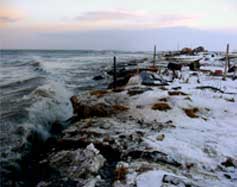Alaska:

Changes
According to the IPCC 2007 working group II report, Alaska's average observed temperature has increased
2 to 3.5° C (~7° F) from 1970-2004; which, along with a neighboring portion of Canada, is
the most extreme change in the world.
One would imagine that Alaskan residents would be the biggest proponents of global warming. When one takes
a closer look, however, the consequences of the changing climate may have drastic impacts on a terrain that
people depend on for their livelihood today, just as their ancestors before them have relied upon.
In the past, the land-based people of the Arctic were able to predict weather and environmental conditions
with a fair amount of certainty. This ability is crucial to survival in the extreme environment. These same
place-based people of today, now considered rural residents of Alaska, are unable to make decisions with
the relative certainty they once had due to the unpredictability climate change has been causing. This can
affect all aspects of life for the people of the north and increase a risk factor that in the past was a
little bit more consistent.
In a place where people depend so much on the land for survival, any slight change in the environment has
an impact on the existence of a livelihood. People's success in coping with the new extreme challenges will
depend on their resilience and adaptive responses.
For more information please contact: